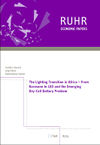Knowledge fuels change
For over a decade, Energypedia has shared free, reliable energy expertise with the world.
We’re now facing a serious funding gap.
Help keep this platform alive — your donation, big or small, truly matters!
Thank you for your support
Difference between revisions of "Off-grid Lighting Transition from Kerosene to LED"
***** (***** | *****) m |
***** (***** | *****) m |
||
| Line 19: | Line 19: | ||
Bensch, G., J. Peters and M. Sievert (2015), [http://en.rwi-essen.de/media/content/pages/publikationen/ruhr-economic-papers/rep_15_579.pdf The lighting transition in Africa – From kerosene to LED and the emerging dry-cell battery problem][http://www.rwi-essen.de/publikationen/ruhr-economic-papers/625/ .] ''Ruhr Economic Papers'' #579. RWI. (open access Working Paper version) | Bensch, G., J. Peters and M. Sievert (2015), [http://en.rwi-essen.de/media/content/pages/publikationen/ruhr-economic-papers/rep_15_579.pdf The lighting transition in Africa – From kerosene to LED and the emerging dry-cell battery problem][http://www.rwi-essen.de/publikationen/ruhr-economic-papers/625/ .] ''Ruhr Economic Papers'' #579. RWI. (open access Working Paper version) | ||
| + | [[Category:Fossil_Fuel]] | ||
| + | [[Category:Publication]] | ||
| + | [[Category:Waste_Management]] | ||
| + | [[Category:Impacts_Environmental]] | ||
| + | [[Category:Lighting]] | ||
[[Category:Off-grid]] | [[Category:Off-grid]] | ||
| − | |||
| − | |||
| − | |||
| − | |||
Latest revision as of 14:49, 6 January 2017
Introduction
Non-electrified people in Africa, still more than 500 million today, have been using kerosene and candles for their lighting purposes for decades. The lighting quality of these sources is low and in particular kerosene usage is associated with harmful soot emissions. Alleviating this grievance has always been a major goal of electrification programs. The present paper shows that in recent years a transition has taken place among the rural non-electrified population in Africa: without any external support from governmental or non-governmental organisations people have replaced kerosene lamps and candles through LED lamps, which are mostly powered by dry-cell batteries.
LED lamps are available in rural shops virtually everywhere and provide brighter and cleaner lighting than traditional lamps. The downside of this massive increase of LED usage is a soaring consumption of dry-cell batteries. Because of the toxic content of many dry-cell batteries and since people dispose of discharged batteries inappropriately in latrines or the nature, harmful effects on the local environment are likely.
This paper has three policy implications.
- Dry-cell battery consumption is escalating in rural regions of Sub-Saharan Africa where waste management systems do not exist. Here, quick action is needed to understand the implications this has for the local environment and, if necessary, to put in place an effective waste management system.
- The implication for socio-economic impact potentials of electrification programs is that households to be electrified will experience fewer impacts on lighting quality and air pollution when using LED lamps instead of fuel-based lamps at baseline. This is of importance for the design of the Sustainable Energy for All initiative, the UN-led global effort to reach all hitherto non-electrified regions with electricity by 2030.
- From a technology adoption perspective it is interesting to shed more light on the LED technology’s success story. Except for mobile phones, no other technology has made such deep inroads to the periphery of the continent without any external support.
Reference
Bensch, G., J. Peters and M. Sievert (2015), The lighting transition in Africa – From kerosene to LED and the emerging dry-cell battery problem. Ruhr Economic Papers #579. RWI. (open access Working Paper version)





















